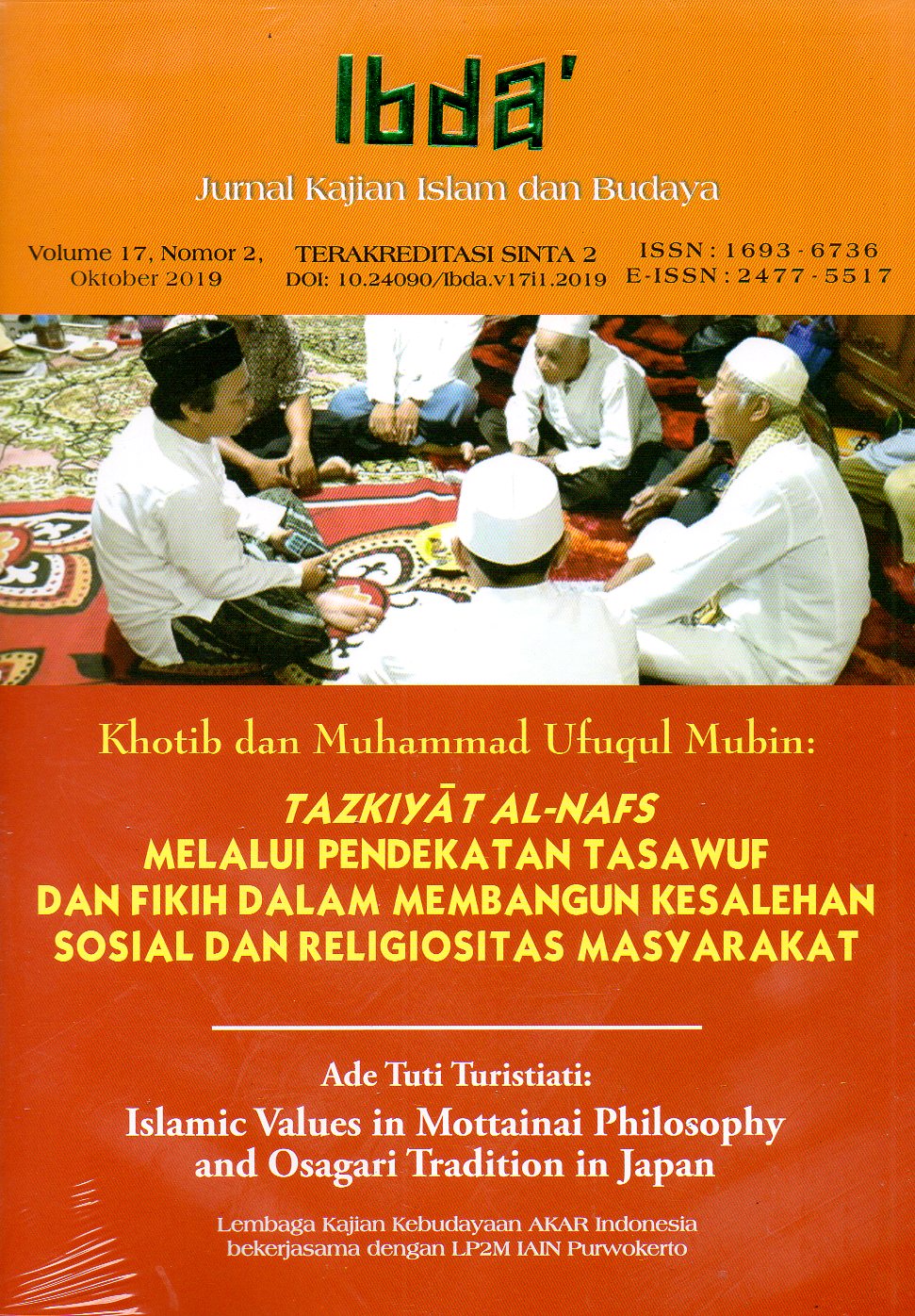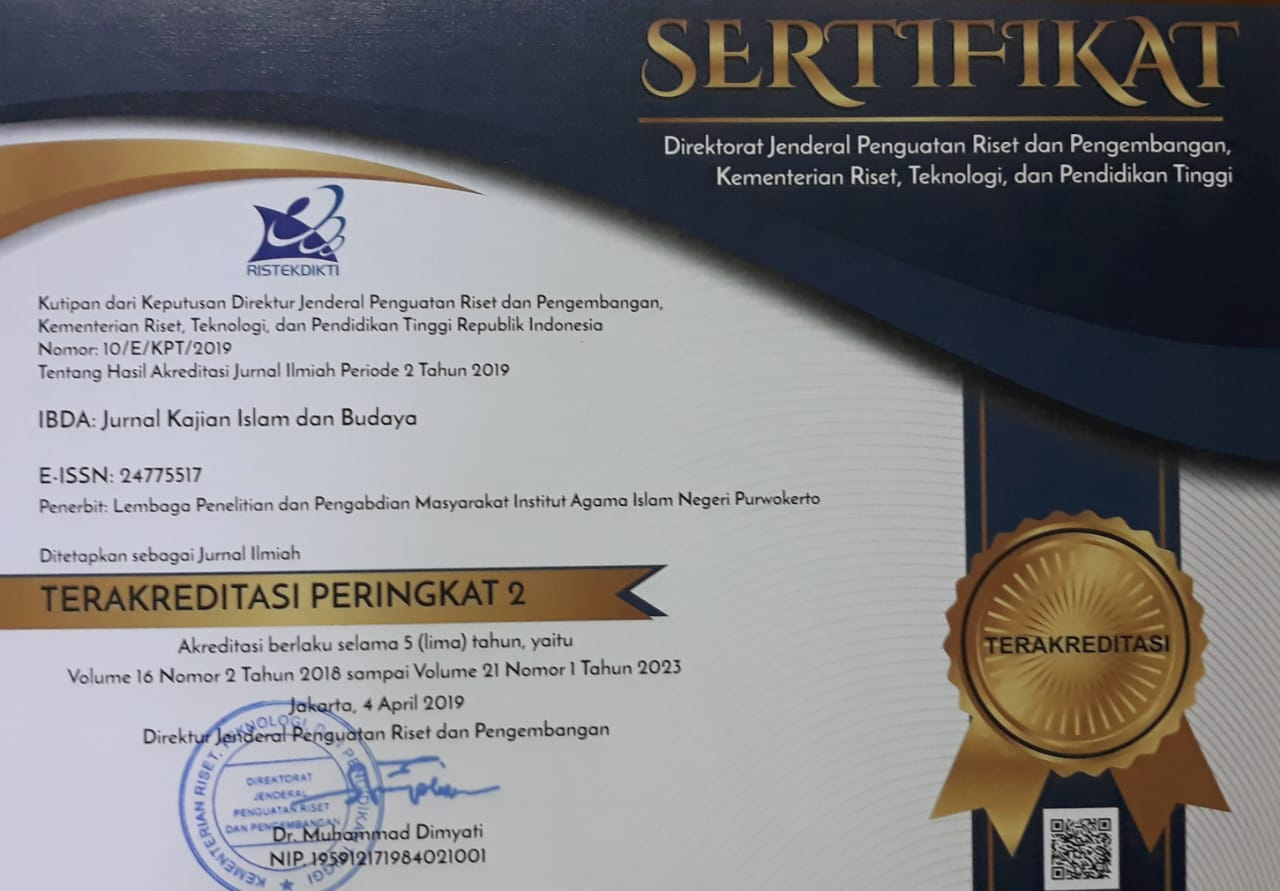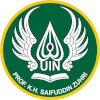THE IMAGE OF PRINCE GEBANG IN BABAD SUTAJAYA MANUSCRIPT
DOI:
https://doi.org/10.24090/ibda.v17i2.2063Kata Kunci:
image, Prince Sutajaya, Principality of Gebang, babad, royal court of CirebonAbstrak
Prince Gebang was one of the local rulers who collaborated with the VOC at the end of the 17th century. His domain, named as the Principality of Gebang (Kepangeranan Gebang), extended from the northern coastal area of Gebang Sea to the south side of the Cijolang River bordering on Galuh. Although the name of Sutajaya is clearly written as Prince Gebang (Pangeran Gebang) in the colonial archives, his identity and his travel process towards the power of the Gebang area was not clearly explained at all. This paper seeks to reveal the image of Prince Gebang through Babad Sutajaya manuscript stored in Pangeran (Prince) Pasarean Museum. From the ancient manuscripts, taken a number of essences related footage Sutajaya figure to study. The historical elements contained in the affinity of the story, comparated with records of colonial archives and sources of oral traditions that exist. From this research it is known that Babad Sutajaya depicts the image of Prince Gebang as an important figure, who came from the royal court of Cirebon. In addition, this manuscript also illustrates Prince Gebang's abilities and reveals how he gained the territory of Gebang as his controlled areaUnduhan
Data unduhan belum tersedia.
Referensi
Baried, Siti Baroroh, dkk. 1994. Pengantar Teori Filologi. Yogyakarta: Fakultas Sastra Universitas Gajah Mada.
Fathurahman, Oman, dkk. 2010. Filologi dan Islam Indonesia. Jakarta: Kementerian Agama RI, Badan Litbang dan Diklat, Puslitbang Lektur Keagamaan.
Fernando, M. Radin. 2013. “Sebuah daftar masa lalu terkait desa, kepala desa, rumah tangga, upeti dan penghasilan di Priangan, Jawa Barat, 1686â€. Dalam: Harta Karun. Khazanah Sejarah Indonesia dan Asia-Eropa dari Arsip VOC di Jakarta. Dokumen 11. Jakarta: Arsip Nasional Republik Indonesia.
Graaf, Hermanus J. de dan Theodore G. Pigeaud, 1974. De Eerste Moslimse Vorstendommen op Java, studien over de staatkundige Geschiedenis van de 15 de en 16 de Eeuw. VKI vol. 69. ‘s-Gravenhage: Martinus Nijhoff.
Irianto, Bambang dan Sutarahardja, Tarka. 2013. Sejarah Cirebon: Naskah Keraton Kacirebonan (Alih Aksara dan Bahasa Teks KCR 04). Muhamad Mukhtar Zaedin dan Panji Darussalam (Eds.). Yogyakarta: Deepublish.
Lukacs, George. 1974. The Historical Novel. London: Merlin Press.
Mubyarto, dkk. 1992. Tanah dan Tenaga Kerja Perkebunan: Kajian Sosial Ekonomi. Yogyakarta: Aditya Media.
Pigeaud, Th, G. Th. 1967. Literature of Java: Catalogue Raisonne of Javanese Manuscripts in The Library of the University of Leiden and Other Public Collections in the Netherlands. Vol. I.
Sjamsuddin, Helius. 2007. Metodologi Sejarah. Yogyakarta: Ombak.
Stapel, F.W. 1935. Corpus Diplomaticum Neerlando-Indicum. Vierde Deel. ‘S-Gravenhage: Martinus Nijhoff.
Tjandrasasmita, Uka. 2006. Kajian Naskah-Naskah Klasik dan Penerapannya Bagi Kajian Sejarah Islam di Indonesia. Puslitbang Lektur Keagamaan, Badan Litbang dan Diklat, Departemen Agama.
Vansina, Jan. 1972. “Once Upon a Time: Oral Traditions as History in Africaâ€, dalam Felik Gilbert and Stephen R. Graubard (eds.), Historical Studies Today. New York: W.W. Norton & Company.
Fathurahman, Oman, dkk. 2010. Filologi dan Islam Indonesia. Jakarta: Kementerian Agama RI, Badan Litbang dan Diklat, Puslitbang Lektur Keagamaan.
Fernando, M. Radin. 2013. “Sebuah daftar masa lalu terkait desa, kepala desa, rumah tangga, upeti dan penghasilan di Priangan, Jawa Barat, 1686â€. Dalam: Harta Karun. Khazanah Sejarah Indonesia dan Asia-Eropa dari Arsip VOC di Jakarta. Dokumen 11. Jakarta: Arsip Nasional Republik Indonesia.
Graaf, Hermanus J. de dan Theodore G. Pigeaud, 1974. De Eerste Moslimse Vorstendommen op Java, studien over de staatkundige Geschiedenis van de 15 de en 16 de Eeuw. VKI vol. 69. ‘s-Gravenhage: Martinus Nijhoff.
Irianto, Bambang dan Sutarahardja, Tarka. 2013. Sejarah Cirebon: Naskah Keraton Kacirebonan (Alih Aksara dan Bahasa Teks KCR 04). Muhamad Mukhtar Zaedin dan Panji Darussalam (Eds.). Yogyakarta: Deepublish.
Lukacs, George. 1974. The Historical Novel. London: Merlin Press.
Mubyarto, dkk. 1992. Tanah dan Tenaga Kerja Perkebunan: Kajian Sosial Ekonomi. Yogyakarta: Aditya Media.
Pigeaud, Th, G. Th. 1967. Literature of Java: Catalogue Raisonne of Javanese Manuscripts in The Library of the University of Leiden and Other Public Collections in the Netherlands. Vol. I.
Sjamsuddin, Helius. 2007. Metodologi Sejarah. Yogyakarta: Ombak.
Stapel, F.W. 1935. Corpus Diplomaticum Neerlando-Indicum. Vierde Deel. ‘S-Gravenhage: Martinus Nijhoff.
Tjandrasasmita, Uka. 2006. Kajian Naskah-Naskah Klasik dan Penerapannya Bagi Kajian Sejarah Islam di Indonesia. Puslitbang Lektur Keagamaan, Badan Litbang dan Diklat, Departemen Agama.
Vansina, Jan. 1972. “Once Upon a Time: Oral Traditions as History in Africaâ€, dalam Felik Gilbert and Stephen R. Graubard (eds.), Historical Studies Today. New York: W.W. Norton & Company.
Unduhan
Diterbitkan
2019-12-31
Cara Mengutip
Sanusi, A., & Tendi, T. (2019). THE IMAGE OF PRINCE GEBANG IN BABAD SUTAJAYA MANUSCRIPT. IBDA` : Jurnal Kajian Islam Dan Budaya, 17(2), 226–241. https://doi.org/10.24090/ibda.v17i2.2063
Terbitan
Bagian
Articles
Lisensi
Authors who publish with this journal agree to the following terms:
- Authors retain copyright and grant the journal right of first publication with the work simultaneously licensed under a Creative Commons Attribution-ShareAlike License a that allows others to share the work with an acknowledgement of the work's authorship and initial publication in this journal.
- Authors are able to enter into separate, additional contractual arrangements for the non-exclusive distribution of the journal's published version of the work (e.g., post it to an institutional repository or publish it in a book), with an acknowledgment of its initial publication in this journal.
- Authors are permitted and encouraged to post their work online (e.g., in institutional repositories or on their website) before and during the submission process, as it can lead to productive exchanges, as well as earlier and greater citation of published work (See The Effect of Open Access).















